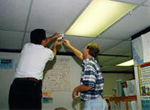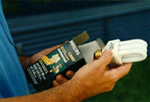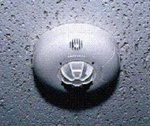
![]()
 Lighting contributes significantly to energy use in buildings, both nonresidential
and residential. Not only do the lights themselves use energy (e.g.
13% of the total energy use in Florida schools) but lights also increase
air conditioning (AC) load by approximately 23%. Thus, lighting significantly
impacts energy use and more energy efficient technologies are advantageous.
Lighting contributes significantly to energy use in buildings, both nonresidential
and residential. Not only do the lights themselves use energy (e.g.
13% of the total energy use in Florida schools) but lights also increase
air conditioning (AC) load by approximately 23%. Thus, lighting significantly
impacts energy use and more energy efficient technologies are advantageous.

Nonresidential lighting: Commonly in place in the nonresidential
sector are the T12 lamp-magnetic ballast lighting systems. Research
has shown that T8 lamp-electronic ballast systems consume less energy,
provide better illumination than T12 systems, and run cooler than the T12
systems.
 Task Lighting: Common incandescent or halogen bulbs varying
energy use from 40 W to 200 W and will also contribute heat gain
to the building. These bulbs should be replaced by compact fluorescent
lamps (CFLs). CFLs provide a similar quality of light, use much less
energy and operate cooler than incandescent and halogen lamps. CFLs
also last up to 10,000 hours compared to 1000 hours for normal incandescent
bulbs. CFLs can save 47% in task lighting energy use with a simple
payback of 2 to 3 years, not including the greater life of the CFLs.
CFLs fit into most existing fixtures so replacement of the fixtures
is not necessary.
Task Lighting: Common incandescent or halogen bulbs varying
energy use from 40 W to 200 W and will also contribute heat gain
to the building. These bulbs should be replaced by compact fluorescent
lamps (CFLs). CFLs provide a similar quality of light, use much less
energy and operate cooler than incandescent and halogen lamps. CFLs
also last up to 10,000 hours compared to 1000 hours for normal incandescent
bulbs. CFLs can save 47% in task lighting energy use with a simple
payback of 2 to 3 years, not including the greater life of the CFLs.
CFLs fit into most existing fixtures so replacement of the fixtures
is not necessary.
 Occupancy
Sensors: occupancy sensor technologies, when used effectively,
can also significantly reduce energy consumption. Infrared or ultrasonic
occupancy sensors can be used to turn on and off lights and the HVAC
system when a room is occupied for a set period of time. These sensor's
relative performance can be expected to vary with space vacancy rates,
timing of occupancy and it's relation to the switch time delay.
Occupancy
Sensors: occupancy sensor technologies, when used effectively,
can also significantly reduce energy consumption. Infrared or ultrasonic
occupancy sensors can be used to turn on and off lights and the HVAC
system when a room is occupied for a set period of time. These sensor's
relative performance can be expected to vary with space vacancy rates,
timing of occupancy and it's relation to the switch time delay.
Daylighting: taking advantage of existing daylight
can save 24% - 51% of lighting electricity use depending on window
orientation and presence of window shading devices. In Florida, shading
is used to reduce heat gain and glare. However, any glazings used
on windows should be spectrally selective allowing in visible light
but rejecting near infrared light. For more information, check out
our Window
Basics page.
Related Publications:
